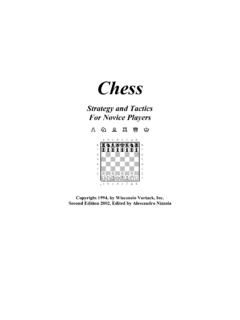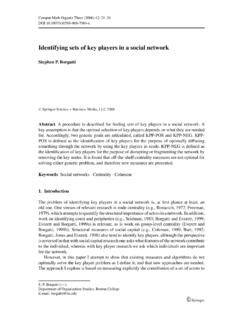Transcription of How To Assess Soccer Players Without Skill Tests
1 How To Assess Soccer Players Without Skill Tests . Tom Turner, OYSAN Director of Coaching and player Development This article was originally created for presentation at the 1999 USYSA Workshop in Chicago. The piece was revised and expanded in December 2000. Evaluating Soccer Players can be a challenging process, particularly when the criteria used for evaluation are not based on the demands of the game. Soccer is a very fluid game when it is performed well; to play at speed, Players must have Skill and vision and tactical insight. However, with novice and experienced coaches alike, there is a tendency to look at Soccer as a series of discrete skills or actions, separate from the game as a whole. This can lead to the development of evaluation criteria that are based more on scores than performance.
2 While a deep knowledge of the discrete components that comprise the game of Soccer is important, and, in fact, serves as one marker that separates the more experienced coach from the novice, there is an inherent danger in thinking about the game in discrete terms when evaluating Players . This is particularly true in try-out situations when Skill Tests are seen as more objective and often utilized to protect inexperienced coaches from unpopular decisions. Let's take a look at passing as an example of the folly and futility of individual Skill testing for the purpose of selecting Players for teams. A common Skill test for passing is to count how many times the ball is exchanged between two Players in 60 seconds using the inside of the foot. In Soccer games, the purpose of passing is to score goals, to take opponents out of the game, or to keep possession of the ball.
3 There are six surfaces of the foot that can be used to pass the ball (inside, outside, heel, toe, instep and sole) and the ball can be passed using a variety of spins, speeds and trajectories. If we separate the tactical aspects of play (when and why do I pass there?) from the technical aspects (what surface and texture is required?), the basic elements of the game are decoupled and we are left with activities that involve technical repetition Without tactical context. In addition, when we choose to test passing skills with a particular surface, it is often at the expense of the others. This can send the message to Players that the other surfaces are either less important, not recommended, or not to be considered. Think about coaches who discourage, and would certainly never test for, passing with the toe, and then consider all the ways the toe can be used as a viable option in problem solving!
4 To take this to the extreme, if we decide to be fair and test all six surfaces, how long will this process take and what time will be left for assessing all the other technical, tactical and physical aspects that constitute the elements of play? Looking from a different perspective, think of practicing passing with one surface as similar to learning to strike just one key on a keyboard. We may become good at striking G, but it doesn't make us think about how to find G in the context of creating a complete sentence, or how G is situated in relation to the other keys. Ironically, practicing only one technique in isolation is actually reinforcing for coaches because Players do improve their ability to perform that particular action. However, the downside to predictable technical repetition in young Players is that those who learn the game in less predictable ways are more likely to develop a deeper understanding of how to adapt their range of techniques to solve novel tactical problems; in short, they become more skilful!
5 While street Soccer may be a thing of the past, think no further than the upbringing of the average NBA player to form an appreciation of its lost value. Creative, skillful Players develop in response to an environment where techniques and tactical awareness develop in unpredictable ways together though hours of unstructured free play. So how does this relate to try-outs? My premise is that quantitative (numerical) measures of ability do not work very well in evaluating Soccer Players . Timed sprints, kicks against a wall, kicking for distance, number of Coerver's in a minute, and various competitions, such as 1v1 Combat, are all examples of activities that have been used to Assess whether Players can play Soccer or not. However, knowing that Suzie can sprint 50 yards in 8. seconds, juggle 5 times with her right foot, kick yards with her left foot, and run through a line of cones in 12 seconds tells us very little about Suzie's ability as a problem-solver under pressure.
6 For that, we need to watch her play Soccer and evaluate how her technique impacts her decision-making. While the task of watching and assessing decision-making within a live game can be quite difficult for the average parent-coach, the following criteria form the basis of a realistic playing evaluation. Assessing Players ' strengths and weaknesses in an authentic setting not only provides information on which Players can actually play Soccer , but also allows coaches the opportunity to target for remediation those areas that are observed to be absent or a hindrance to good performance. Consider how realistic it would be to tell a parent that their child is on the B or C team because they don't yet understand how to create space, or they can't keep possession of the ball when under pressure, or their tactical understanding does not allow them to play in combination with others, or that they simply take too many touches and play too slowly.
7 Contrast that message with the information that their child is on the B or C team because they can't run fast enough, juggle well enough, dribble through a line of cones under control, or because they finished bottom of a competitive heading ladder. In reality, the differences between the scores of young Players may be one or two juggles or one or two seconds, or one or two feet. We must ask if those differences really tell us anything of substance about that person as a Soccer player ? The suggested games for observing Players under the age of ten are 2v2, 2v2+1, 3v3, 3v3+1, 4v4, and 5v5. While 5v5 is the best option to Assess 9 and 10 year-olds, younger or very inexperienced children might find these numbers too complicated. For Players older than ten, games of 8v8 and 11v11 should be used to complement games of 5v5.
8 The smaller-sided games can be played to a line (dribble over the line in control to score), to a target player on the end line (pass to the target player to score / use the other team's target as a support player ), or to a goal (with or Without goalkeepers). Eight versus eight and 11v11 should always be played to goals and with goalkeepers. The field sizes will vary, but generally 2v2 is played on a field of 15x25 yards, 3v3 on a field of 20x30 yards, 4v4. on a field of 25x40 yards, and 5v5 on a field of 30x40 yards. The 8v8 field is 50x70. yards. Here are the criteria used for evaluation. Because Players under the age of 10 have not developed a sense of group tactics, the following criteria deal with individual technical and tactical issues. 1. Does the player understand which goal to attack and which to defend?
9 Have they established a sense of Soccer DIRECTION? 2. Does the player try to CONTROL THE BALL when it comes to them, or do they look to kick it away? 3. Is the player COMFORTABLE WHEN DRIBBLING the ball? Does the player try to keep the ball close to their body? 4. Does the player try to use a VARIETY OF SURFACES when turning and running with the ball? 5. Is the player TWO FOOTED? 6. Does the player ATTACK OPEN SPACE when they have time and space to dribble the ball forward? 7. Does the player recognize when to DRIBBLE AWAY FROM PRESSURE? Does the player have the spatial awareness to perceive pressure and move into an open space with the ball? 8. Given time and space, does the player have the technical skills TO BEAT AN. OPPONENT and maintain possession? 9. Does the player MOVE INTO OPEN SPACES to receive passes?
10 Does the player stand behind other Players or do they perceive open space and move away from the crowd? 10. Does the player naturally MOVE WITH THE GAME, or do they kick the ball and stand still? 11. Does the player SCORE GOALS? Does the player naturally look to score goals and do they have the vision and technique to score by design? 12. Does the player try to RECOVER THE BALL when the other team has possession? In addition to the elements used to Assess Players under the age of ten, the following criteria should also be used to Assess Players older than ten. 1. Does the player understand how to SPREAD OUT? Where should the player move to give the team a playing shape and create space between the defenders? Does the team have Players on either side of the field and in the front and in the back?







